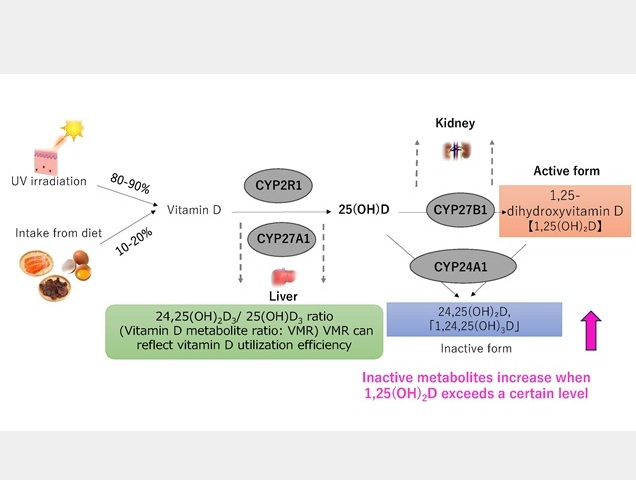Research News
Oct 3, 2025
- Human Life and Ecology
Association between serum vitamin D metabolite levels and cognitive function in community-dwelling older adults
Vitamin D metabolism
Concentrations of serum vitamin D were compared and assessed Alzheimer's risks.
Credit: Osaka Metropolitan University

Vitamin D deficiency has been associated with cognitive decline and Alzheimer's disease (AD); however, findings remain inconsistent. Assessing vitamin D status based solely on the serum total 25-hydroxyvitamin D [25(OH)D] level may be insufficient, and other metabolites, such as 24,25- dihydroxyvitamin D3 [24,25(OH)2D3] and 3-epimer-25-hydroxyvitamin D3 [3-epi-25(OH)D3], may provide additional insights. This study aimed to examine the association between serum vitamin D metabolite concentrations and cognitive function in older adults.
A research team led by Osaka Metropolitan University conducted a cross-sectional study using Biobank samples from the National Center for Geriatrics and Gerontology (NCGG), involving 289 community-dwelling individuals aged 65 to 85. Participants were clinically diagnosed with either Alzheimer’s disease (AD), mild cognitive impairment (MCI), or had normal cognitive function (CN). Cognitive function was assessed using the Mini-Mental State Examination (MMSE). Serum concentrations of 25(OH)D3, 25(OH)D2, 24,25(OH)2D3, 3- epi-25(OH)D3, and 1,25-dihydroxyvitamin D3 [1,25(OH)2D3] were measured using liquid chromatography-tandem mass spectrometry (LC-MS/MS). The Vitamin D metabolite ratio (VMR) was calculated as 24,25(OH)2D3/25(OH)D3 × 100 (%). Associations among metabolite concentrations, MMSE scores, and AD prevalence were analyzed.
Participants had relatively high serum total 25(OH)D levels (median: 23.5 ng/mL), with males showing higher vitamin D metabolite concentrations. Total 25(OH)D correlated with 24,25(OH)2D3, 3- epi-25(OH)D3, and VMR. In males, 3-epi-25(OH)D3 and 24,25(OH)2D3 were associated with lower MMSE scores and higher AD prevalence risk. In females, VMR was associated with higher MMSE scores and lower AD prevalence risk, while 1,25(OH)2D3 was linked to higher AD risk and quartile 2 with lower MCI risk.
Sex-based differences in vitamin D–cognition associations may reflect disparities in vitamin D levels and hormonal effects, such as estrogen-enhancing and testosterone-suppressing metabolism. Further, 1,25(OH)2D3, VMR, and 3-epi-25(OH)D3 may be more sensitive than total 25(OH)D.
Paper information
Journal: Clinical Nutrition ESPEN
Title: Association between serum vitamin D metabolite levels and cognitive function in community-dwelling older adults: A cross-sectional study
DOI: 10.1016/j.clnesp.2025.08.032
Authors: Cai Yu, Minae Ide, Taiki Sugimoto, Rei Otsuka, Koji Takahashi, Masaki Takiwaki, Kiyoshi Tanaka, Hiroaki Kanouchi, Shigeo Takenaka, Takashi Sakurai, Shumpei Niida, Akiko Kuwabara
Published: 3 September 2025
URL: https://doi.org/10.1016/j.clnesp.2025.08.032
Contact
Akiko Kuwabara
Graduate School of Human Life and Ecology
Email: kuwabara.akiko[at]omu.ac.jp
*Please change [at] to @.
SDGs

